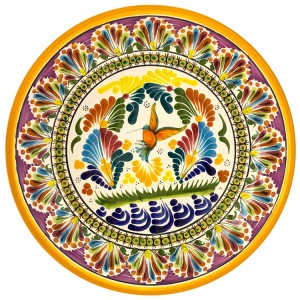 Talavera Ceramic is mostly used to make utilitarian items such as plates, bowls, jars, flowerpots, sinks , religious items and decorative figures. However, a significant use of the ceramic is for Talavera Tiles .
Talavera Ceramic is mostly used to make utilitarian items such as plates, bowls, jars, flowerpots, sinks , religious items and decorative figures. However, a significant use of the ceramic is for Talavera Tiles .
Talavera was introduced to Mexico by Spanish guild artisans of the Colonial period. Known as “majolica” in Spain, Mexican Talavera draws its name from the 16th century Spanish pottery center, Talavera de la Reina , where imagination and persistence led to enormous strides in the world’s knowledge of fine ceramics. The tradition of Talavera production has struggled since the Mexican War of Independence in the early 19th century, during which the number of workshops were less than eight in the state of Puebla. Later efforts by artists and collectors revived the craft somewhat in the early 20th century and there are now significant collections of Talavera pottery in Puebla, Mexico City and New York City. Further efforts to preserve and promote the craft have occurred in the late 20th century, with the introduction of new, decorative designs and the passage of the Denominación de Origen de la Talavera law to protect authentic, Talavera pieces made with the original, 16th-century methods.
“Travel across Mexico , and you’ll see all sorts of signs of Spanish influence that date back to the colonial era. Architecture, of course, is chief among them—but there’s also talavera. More than 300 years later, the popular style endures. The colorful ceramics are found in the form of decorative tiles adorning buildings’ exterior and interior walls (one of the most spectacular examples is the Casa de los Azulejos in Mexico City), as well as in the form of Talavera Plates , bowls, and other serving dishes found in Mexican kitchens and on dining room tables.” – The Latin Kitchen
